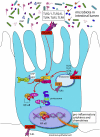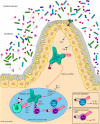Epithelial crosstalk at the microbiota-mucosal interface
- PMID: 20826446
- PMCID: PMC3063605
- DOI: 10.1073/pnas.1000092107
Epithelial crosstalk at the microbiota-mucosal interface
Abstract
This article provides an overview of how intestinal epithelial cells (IEC) recognize commensals and how they maintain host-bacterial symbiosis. Endocrine, goblet cells, and enterocytes of the intestinal epithelium express a range of pattern recognition receptors (PRR) to sense the presence of microbes. The best characterized are the Toll-like receptors (TLR) and nucleotide oligomerization domain-like receptors (NLR), which play a key role in pathogen recognition and the induction of innate effectors and inflammation. Several adaptations of PRR signaling have evolved in the gut to avoid uncontrolled and potentially destructive inflammatory responses toward the resident microbiota. PRR signaling in IEC serve to maintain the barrier functions of the epithelium, including the production of secretory IgA (sIgA). Additionally, IECs play a cardinal role in setting the immunosuppressive tone of the mucosa to inhibit overreaction against innocuous luminal antigens. This includes regulation of dendritic cells (DC), macrophage and lymphocyte functions by epithelial secreted cytokines. These immune mechanisms depend heavily on IEC recognition of microbes and are consistent with several studies in knockout mice that demonstrate TLR signaling in the epithelium has a profoundly beneficial role in maintaining homeostasis.
Conflict of interest statement
The authors declare no conflict of interest.
Figures



References
-
- Salzman NH, Underwood MA, Bevins CL. Paneth cells, defensins, and the commensal microbiota: A hypothesis on intimate interplay at the intestinal mucosa. Semin Immunol. 2007;19:70–83. - PubMed
Publication types
MeSH terms
Substances
LinkOut - more resources
Full Text Sources
Medical
Miscellaneous

